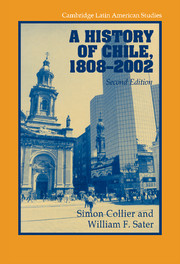Book contents
- Frontmatter
- Contents
- List of maps
- Preface to the Second Edition
- A note on geography
- CAMBRIDGE LATIN AMERICAN STUDIES
- PART I Birth of a nation-state, 1800s–1830s
- 1 Colonial foundations, 1540–1810
- 2 Independence, 1808–30
- 3 The conservative settlement, 1830–41
- PART II The rise of a republic, 1830s–1880s
- PART III The nitrate era, 1880s–1930s
- PART IV Industrial advance and the dawn of mass politics, 1930s–1960s
- PART V Democracy and dictatorship, 1960s–2000s
- Glossary of Spanish terms
- Initials and acronyms
- Further reading
- Index
1 - Colonial foundations, 1540–1810
Published online by Cambridge University Press: 05 June 2012
- Frontmatter
- Contents
- List of maps
- Preface to the Second Edition
- A note on geography
- CAMBRIDGE LATIN AMERICAN STUDIES
- PART I Birth of a nation-state, 1800s–1830s
- 1 Colonial foundations, 1540–1810
- 2 Independence, 1808–30
- 3 The conservative settlement, 1830–41
- PART II The rise of a republic, 1830s–1880s
- PART III The nitrate era, 1880s–1930s
- PART IV Industrial advance and the dawn of mass politics, 1930s–1960s
- PART V Democracy and dictatorship, 1960s–2000s
- Glossary of Spanish terms
- Initials and acronyms
- Further reading
- Index
Summary
The kingdom of Chile, without contradiction the most fertile in America and the most adequate for human happiness, is the most wretched of the Spanish dominions.
– Manuel de Salas (1796)The first Europeans arriving in Chile were charmed and captivated by its natural beauty and generally moderate climate. “This land is such that for living in, and for settling, there is none better in the world,” wrote Pedro de Valdivia, the Spanish conquistador who opened up the fertile Central Valley of Chile to European colonization in 1540. It is easy enough to see how Valdivia and his men, coming from a fairly arid homeland, having marched southward from Peru through endless desert, should have taken pleasure in the softer tones of the Chilean landscape. From the first, however, the colonizers' enjoyment of this scenery was bought at the price of isolation from the rest of the world. At no time was this truer than during the two and a half centuries that followed Valdivia's successful invasion, the period when the deep foundations of modern Chilean culture and nationality were laid. If Chileans form, as they do, a distinctive branch of the Spanish American family, the key to understanding their distinctiveness is, precisely, their long isolation – mitigated to an extent by the steamship in the second half of the nineteenth century, and more so by the jet airliner in the second half of the twentieth.
- Type
- Chapter
- Information
- A History of Chile, 1808–2002 , pp. 3 - 31Publisher: Cambridge University PressPrint publication year: 2004

